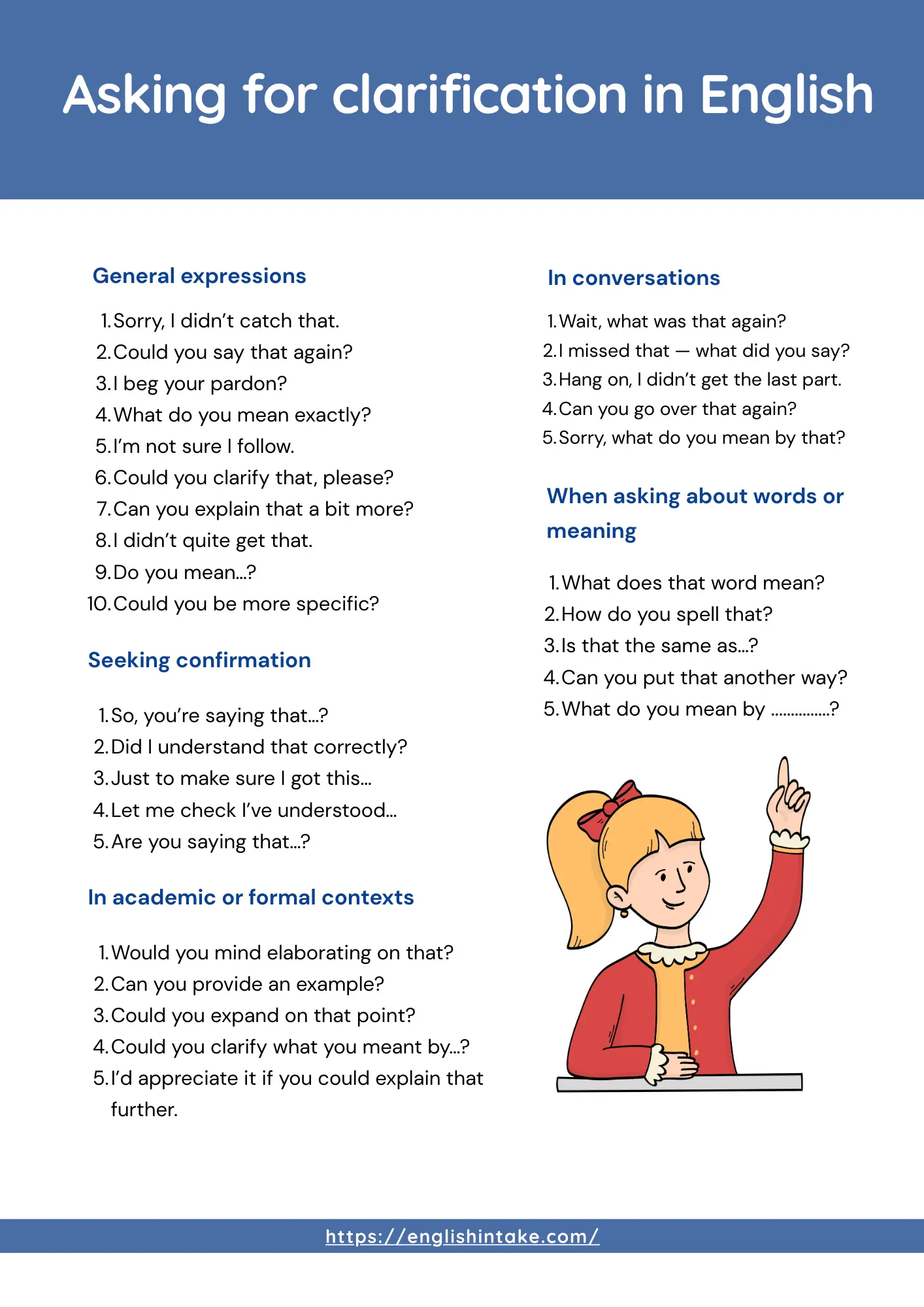1. Why asking for clarification is important?
When we are not sure what someone has said or what they meant, we can request further clarification or ask them to repeat their words. This ensures that you understand the text-blue-med correctly and can respond appropriately.
In this vocabulary lesson, we will explore various expressions you can use to ask for clarification in English, along with example sentences to illustrate their use.
2. English expressions to ask for repetition and clarification
When you didn’t catch something or need more details, asking for repetition and clarification is a valuable communication skill. Here are some phrases you can use to make sure you’re on the same page with the speaker:

Examples:
1. Could you please repeat that?
2. Could you say that again, please?
3. Could you repeat that, please?
4. orry, what was that?
5. What did you say? (informal)
6. I beg your pardon?
7. I didn’t get it
8. I didn’t hear you clearly, could you repeat that?
9. What do you mean by that?
10. What exactly does ... mean?
11. Are you saying that ...?
12. Could you go over that again, please?
13. Did you mean ...
14. Did you say ...
15. I am not sure I got your point.
16. I’m not sure I understood your point about ...
17. I want to make sure I understand. Are you suggesting that...?
18. I’m afraid I couldn’t (quite) follow everything you said.
19. Could you repeat what you said about ... please?
20. What does ... refer to in this context?
21. Sorry, but I don’t quite follow you.
22. I’m sorry, but I’m not sure I understand what you mean by ...
3. Giving clarification phrases
When someone asks for more details or clarification , they want to understand you better. It’s a chance to explain your thoughts more clearly. You can repeat your words, rephrase what you just said, or give examples. Here are various expressions and phrases you can use to respond to someone’s request for clarification.
Examples:
1. Let me explain ...
2. I will give you an example ...
3. What I meant to say was ...
4. To clarify, I was referring to ...
5. Let me explain that in more detail.
6. In other words ...
7. To put it another way ...
8. Let me rephrase that.
9. What I’m trying to say is...
10. To be more specific...
11. If I understand you correctly, you’re asking about ...
12. Just to be clear ...
13. I’d like to point out that ...
14. What I was getting at was ...
15. The key point I’m making is ...
16. To expand on that point ...
17. What I mean by that was ...
18. Perhaps I should make myself more clear.
19. Allow me to elaborate on that.
20. If you’re asking whether..., the answer is ...
21. Let me clarify what I mean.
22. My point was actually ...
23. What I intended to say was ...
24. The main idea I wanted to convey was ...
25. That’s a good question. To clarify ...
26. Let me clear up any confusion about...
27. To answer your question more directly ...
28. In response to your query ...
29. If I may clarify this part ...
30. What you need to understand is ...
31. If I can just add some context to that...
4. Tips to ask for clarification
Here are some tips to help you communicate more effectively:
1. Don’t hesitate to ask: Always ask if you’re unsure about something. It’s better to seek clarification than to misunderstand.
2. Be polite: Use polite phrases like "Could you please clarify...?" or "I’m sorry, but I didn’t quite understand..."
3. Be specific: Specify what you didn’t understand. For example, "Could you explain what you mean by ...?" or "I’m not sure I understand the part about..."
4. Use clarifying questions: Phrases like "Do you mean...?" or "Are you saying that...?" are helpful to confirm your understanding.
5. Repeat what you heard: This not only shows you are paying attention but also allows the speaker to correct any misunderstandings. E.g., "So, am I right in thinking that...?"
6. Ask for examples: If a concept is unclear, ask for examples or illustrations to grasp it better.
7. Take notes: Writing down key points can help you remember and clarify your thoughts when asking questions.
8. Use body language: Non-verbal cues like nodding or looking confused can prompt the speaker to elaborate or explain differently.
9. Practice active listening: Focus on what is being said, and avoid formulating your response while the other person is still speaking.
11. Summarise the explanation: After receiving clarification, summarise the explanation to confirm your understanding.
12. Don’t pretend to understand: If you’re still confused after an explanation, it’s okay to ask for further clarification.
13. Use paraphrasing: Rephrase what was said in your own words and ask if your interpretation is correct.
14. Learn clarification phrases: Familiarise yourself with various phrases and expressions used for asking for clarification.
15. Avoid interrupting: Wait for a natural pause in the text-blue-med to ask for clarification.
16. Be patient: Sometimes it might take more than one attempt to understand something fully, especially when dealing with complex topics or language.
Being able to ask for clarification and answer questions is important for good communication. Using these tips can help you communicate better and make sure others understand you too. This is helpful in any situation - at work, in school, or just talking with friends. Practice these skills to help you feel more confident when speaking English.
